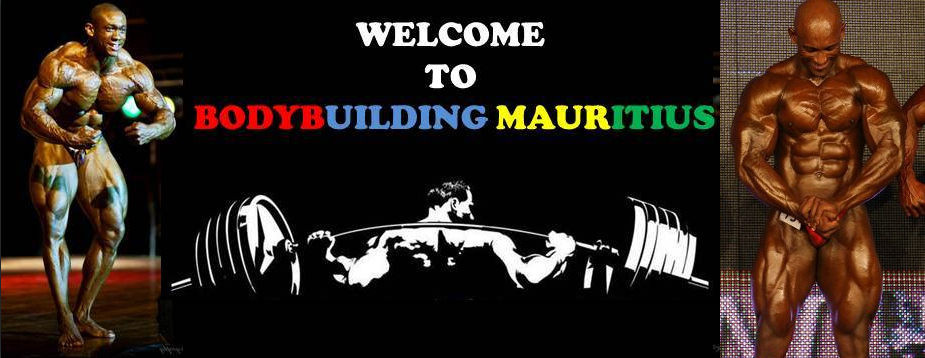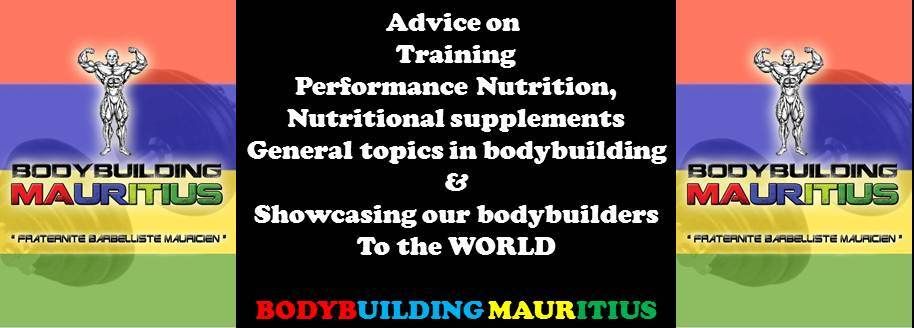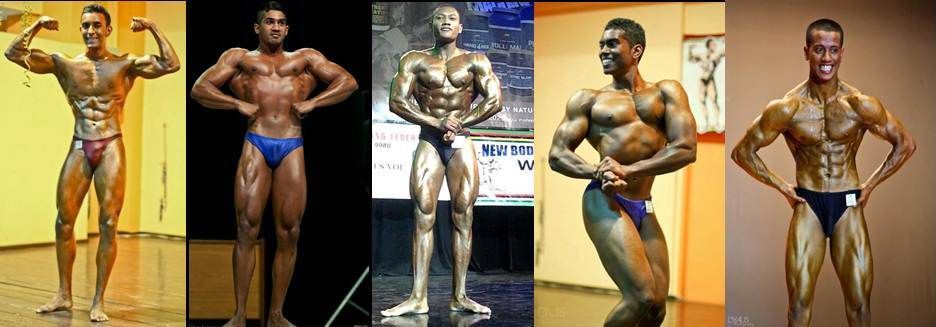Getting those Gunns
to GROW
My personal training
tips
By Vic Goyaram Exclusive for Bodybuilding Mauritius
Every bodybuilder wants massive arms. There isn't anything like arms which are too big. In a recent post on our Facebook page we have all seen members' willingness to get bigger arms. In this article I will share some of my best advice on how to get your arms to grow. These are personal tips that have worked for me and I am sure they can do a lot for your arms too.
 |
| Want to take your physique to the next level? Email me to receive my brochure vicgoyaram@gmail.com |
Tip # 1: Do not neglect the triceps and brachialis
The triceps make up a big proportion of the upper arm and is a great contributor of overall arm mass. Therefore, in your quest for massive arms do not forget to tap on the growth potential of the triceps. Unfortunately, it is not uncommon to see the biceps getting more work in training routines in gyms worldwide, much to the neglect of other muscles that constitute the arms.
 |
| Do not waste your triceps' growth potential Work the freaking triceps! |
The brachialis is the muscle which sits in your outer arm between the triceps and the biceps. In addition to contributing a lot to your pulling strength, the brachialis does a lot to contribute to overall arm growth. They get a lot of indirect work in rowing and pulldown movements. Good exercises to work them directly are the hammer curls and the reverse barbell curls. I prefer to do my hammer curls as in the picture below. This is called the cross-body or pinwheel hammer curl. I find it less stressful to my shoulder joint than conventional hammer curls and this allows me to move more weight. Secondly, make sure to not shrug in an attempt to move the weight up. The only movement must occur at the elbow joint. Pause slightly at the top. Perform in an alternate manner or one arm at a time for greater focus.
 |
| My favourite version of hammer curls: Cross-body hammer curls |
Besides contributing to overall arm mass, the triceps are very important for your pushing strength. A strong pair of triceps means better chest and shoulder pressing strength. A list of the finest triceps exercises are given in the chart below. Good exercises for the triceps include triceps pushdowns, skull crushers and various overhead extensions.
 |
| The Mauritius Muscle Power Series Triceps Chart |
1. Triceps pushdowns
I like to open my triceps routine with triceps pushdowns as I feel that it warms up my elbow joints for the free weight movement to come next in the routine. When I train my triceps after a pushing body-part (chest or shoulders) I perform two triceps exercises and sometimes three. One of them is the cable pushdowns and the other are free weight movements. With this exercise I like to maintain a slight forward bend in the torso as this helps me get a good contraction at the bottom. Lately, I have been bending my torso even more as in the picture of Doug Brignole below. This allows for a much better contraction and my results have been amazing.
 |
| Triceps cable pushdowns |
 |
| My new favourite triceps pushdown position. This allows for a solid contraction at the bottom of the movement (Photo courtesy of Doug Brignole, Mr. Universe and exercise expert)\ Click to visit his webpage |
 |
A. As a stand-alone exercise
B. At the end of a regular triceps pushdown set to grind additional reps after reaching failure
There is a full article on this exercise on our website.
 |
| The triceps pressdown |
 |
| The French press |
 |
| The above exercises have helped me beef up my triceps |

Tip #2: Do not neglect the forearms
Developed forearms are important for both aesthetic reasons and for grip strength for executing a variety of exercises for both the biceps and other body-parts. Having a strong grip means you'll be able to handle the heavy weights to overload the biceps and triceps without your grip failing first. So make sure you train them. I like to train them after back and after biceps (twice a week) and improving my forearms has greatly improved both my arm and back training. Contrary to what some people may believe or tell you, forearm work is not for sissies and a bodybuilder would do well to incorporate forearm work into his routine.
One of my favourites is the reverse barbell curl. I usually perform these for 5 sets twice a week at the end of my biceps and back days. 2 sets of 15 reps with lb barbells and 3 sets x 10 reps with 65lb barbells. This movement blasts the biceps, upper forearm (brachioradialis) and brachialis directly. Talk about arm growth in thickness. I guarantee this is a compound movement for the arm. Talking of the brachioradialis muscle, I have devoted an article to this muscle already (Beefing the Upper forearm)
One of my favourites is the reverse barbell curl. I usually perform these for 5 sets twice a week at the end of my biceps and back days. 2 sets of 15 reps with lb barbells and 3 sets x 10 reps with 65lb barbells. This movement blasts the biceps, upper forearm (brachioradialis) and brachialis directly. Talk about arm growth in thickness. I guarantee this is a compound movement for the arm. Talking of the brachioradialis muscle, I have devoted an article to this muscle already (Beefing the Upper forearm)
 |
| Don't forget to kill the forearms |
Tip#3: Avoid over-training
Arms are the most commonly
overtrained body-part Some people train arms two or more times a
week. Some of you have even spotted others doing arms everyday, I'm sure! This
is too much work for the arms, considering that the biceps and triceps are also
involved respectively in back and chest/ shoulder training. Keep your arm
training short but intense. You may give arms a day on their own if you think
they need special attention or need a shock therapy. Otherwise, you can also
attain good growth by doing biceps after back and triceps after chest or
shoulders. Always experiment to see what approach gives you better results. At
the same time keep variety in your routine.
 |
Tip#4: Try Positions of Flexion (POF) training
I have obtained the fantastic results using a system called the "Position of Flexion" (POF) system, developed by Steve Holman of Ironman magazine. I read it from his book sometime in the mid 2000s and this coincided with the first time my arms hit the 16.5 inch mark. Positions of Flexion training deserves an article on its own but briefly it consists of working each muscle in the midrange, stretch and contracted position.
I have obtained the fantastic results using a system called the "Position of Flexion" (POF) system, developed by Steve Holman of Ironman magazine. I read it from his book sometime in the mid 2000s and this coincided with the first time my arms hit the 16.5 inch mark. Positions of Flexion training deserves an article on its own but briefly it consists of working each muscle in the midrange, stretch and contracted position.
 |
| POF biceps exercises performed by Arnold. |
Biceps still sore from back day
I am sure that many people have been confronted with this dilemma: you have trained back very hard and for the next couple of days not only your back but your biceps are also very sore. But then comes the time to work your biceps and your biceps are still sore. What to do? Train the biceps and allow them to recover? I would suggest to let them recover before attempting to blast them again. My biceps are always pumped during back workouts and sore the next day no matter how much I focus on pulling with my back and using my arms as hooks on back exercises. To remedy this problem I have resorted to training biceps after back several years ago and the results have been amazing.
Of course training biceps after back may mean that your biceps are already pre-exhausted and this you won't be able to lift as much as on an arms-only day. That's not a big problem because, as we just said, the biceps are pre-exhausted. You wouldn't need as many exercises to completely exterminate the biceps. When I train biceps after back I usually perform 4 sets of barbell curls followed by 3 sets of hammer curls. Then I am done for the day. I suggest that you always experiment what works for you. If you can space your back and biceps days then go ahead with it.
Unproductive and productive exercises
We all
have exercises which gives us the best results and I will suggest that's where
your effort must be spent. Do not spend your time on exercises that are
unproductive for you. If bench dips give you more pain in your elbows and
shoulders than a good workout in spite of you having tried you best,
then ditch them. Do not insist on performing them just because your
training partner is growing from them. Listen to your body and tailor your
program accordingly. I do not like bench dips because they give me pain in my
elbows and shoulders. Therefore, ditched them from my routine although I will
perform them using bodyweight resistance from time to time.
Tip #6: My Secret biceps exercises
Drag curls
One of the most productive biceps exercises for me are barbell drag curls. This is a Vince Gironda article and has been discussed on an article dedicated entirely to it (Click to read)
Dreher dumbbell curls
This is amazing tip that I got from Mr. Universe and former IFBB Pro Dr. Lance Dreher in a chat conversation. Dr. Lance Dreher is one of my role models and the owner of the freakiest pair of arms in the pro ranks back in the day. In his honour will call this exercise the Lance Dreher dumbbell curls. These curls are performed by using "asymmetric grips" on the dumbbell curls as follows:
Grip A: Thumb side of your hands in contact with the inner side of the plates of the dumbbell.
Grip B: Pinkie finger in contact with the inner side of the dumbbells (pictured below)
You would need to perform these curls by starting in a hammer fashion and then supinate (more the palms upwards) as you complete the rest of the curl. With the use of the asymmetric grip you are able to activate your outer biceps (long head) to a greater extent with grip (a) and inner biceps (short head) with grip (b).
Zottmann curls
Zottmanns are one of the best exercises to thicken the entire arms. It is not always comfortable to perform in the beginning and it takes a bit of practice to master the technique and build the mental connection on of this exercise. You start the curl with palms facing up and once you reach the top of the movement pronate your wrist (turn downwards). On the negative portion of the rep you are in fact performing the eccentric portion of a reverse curl. It is best to keep the elbows close to the body rather than allow them to flare out. Lower the weight if necessary to achieve perfect form. Zottmanns can be performed standing or seated and two arms at the same time or in an alternate fashion.
You can read a full article on this exercise on this site.
Tip #7: Focusing on compounds
Drag curls
One of the most productive biceps exercises for me are barbell drag curls. This is a Vince Gironda article and has been discussed on an article dedicated entirely to it (Click to read)
 |
| Barbell drag curls |
This is amazing tip that I got from Mr. Universe and former IFBB Pro Dr. Lance Dreher in a chat conversation. Dr. Lance Dreher is one of my role models and the owner of the freakiest pair of arms in the pro ranks back in the day. In his honour will call this exercise the Lance Dreher dumbbell curls. These curls are performed by using "asymmetric grips" on the dumbbell curls as follows:
Grip A: Thumb side of your hands in contact with the inner side of the plates of the dumbbell.
Grip B: Pinkie finger in contact with the inner side of the dumbbells (pictured below)
You would need to perform these curls by starting in a hammer fashion and then supinate (more the palms upwards) as you complete the rest of the curl. With the use of the asymmetric grip you are able to activate your outer biceps (long head) to a greater extent with grip (a) and inner biceps (short head) with grip (b).
 |
| Dr. Lance Dreher performing his namesake curls (Check his grip on the dumbbells) |
 |
| Dr. Lance Dreher during his competitive heyday |
Zottmanns are one of the best exercises to thicken the entire arms. It is not always comfortable to perform in the beginning and it takes a bit of practice to master the technique and build the mental connection on of this exercise. You start the curl with palms facing up and once you reach the top of the movement pronate your wrist (turn downwards). On the negative portion of the rep you are in fact performing the eccentric portion of a reverse curl. It is best to keep the elbows close to the body rather than allow them to flare out. Lower the weight if necessary to achieve perfect form. Zottmanns can be performed standing or seated and two arms at the same time or in an alternate fashion.
You can read a full article on this exercise on this site.
 |
| The Zottmann curls: another forgotten old school exercise |
As mentioned earlier the biceps, triceps and forearms get plenty of work from being used as assisting muscles in a variety of lifts for other body-parts. Therefore it makes sense that you will get a lot of arm growth if you also focus on such compound movements like rows and presses.
Tip #8: Build the entire body and be realistic
If you add mass to your overall frame it will be unlikely that you arms will resemble twigs. Therefore, to make improvements in your arm mass you have to add mass to your entire body. You cannot kill yourself on arm training, neglect the rest of the body and expect the arms to grow disproportionately. There is a certain degree of asymmetry that the body can take. In order to illustrate this point I will borrow a few paragraphs from renowned trainer Charles Poliquin:
 |
| Click to read full article |
We all want to reach the mythical 20" arms. But in the process we have to be realistic. I quote Arthur Jones, the inventor of the Nautilus training machines and father of High Intensity training and refer you to his article on arm size (Click here)
"The largest muscular arm that I ever measured – or saw –was Sergio Oliva's,
which, accurately measured, "cold" was 20 1/8 inches. Arnold Schwarzenegger's arm was 19 7/8, slightly pumped –
probably 19 1/2 "cold". Bill Pearl's largest arm, his left arm, was 18 5/8 at a bodyweight of 222 in 1960 – at the
1971 NABBA Mr. Universe contest in London, his publicized arm size was listed as 20 1/4, but it was obvious
to me that his arms were actually smaller than when I measured them in 1960, and it was obvious to anybody who
saw the two men side by side that Sergio's arms literally dwarfed Bill's arms, and now you know how big
Sergio's arms were at the time. Casey Viator's arms were 19 15/16 at their largest when he
was training in DeLand – and were 18 1/16 when he first
came to DeLand, immediately after the Mr. America contest in 1970"
My Bio: I am a Mauritian originally from Roche Bois, Port Louis and now based in Cape Town, South Africa where I am busy with my postgraduate studies in molecular biology of exercise. My research, supervised by Prof. Edward Ojuka and Dr. Tertius Kohn, looks at the influence of nutrition and exercise in gene expression in muscle, research which is relevant and applicable to exercising individuals, sports persons and diabetic individuals. The knowledge that I share with you stems from my 18 years of experience in bodybuilding and 8 years (and counting) of university education in the field. I have also published work in the American Journal of Physiology: Endocrinology and Metabolism (2012, 2014), International Journal of Sport Nutrition and Exercise Metabolism (2013) and co-authored two book chapters on exercise and diabetes. I also presented my research work at the 2012 International Sports and Exercise Nutrition Conference (UK). I am grateful to each and everyone at the UCT Research Unit for Exercise Science and Sports Medicine. "Knowledge without sharing is worth nothing"
I am doing diet and training consultations
If you want to make sick gains
I analyse your physique, diet and training
PERSONALISED PROGRAMS
Email me: vicgoyaram@gmail.com
Email me: vicgoyaram@gmail.com
------------------------------------------
Join us for discussions on our facebook group
Free advice & daily bodybuilding talk
Your #1 Bodybuilding destination in Mauritius
Free advice & daily bodybuilding talk
Your #1 Bodybuilding destination in Mauritius
_________________________________________________________________________
©,2013, Veeraj Goyaram, Bodybuilding Mauritius. Any reprinting in any type of media is prohibited.
Disclaimer: The Content on this site is intended to be used for educational and entertainment purposes only. It is not intended to be and should not be interpreted as medical advice or a diagnosis of any health or fitness problem, condition or disease; or a recommendation for a specific test, doctor, care provider, procedure, treatment plan, product, or course of action. BODYBUILDING MAURITIUS is not a medical or healthcare provider and your use of this site does not create a doctor / patient relationship. We disclaim all responsibility for the professional qualifications and licensing of, and services provided by, any physician or other health providers posting on or otherwise referred to on this Site and/or any Third Party Site. Never disregard the medical advice of your physician or health professional, or delay in seeking such advice, because of something you read on this Site. We offer this Site AS IS and without any warranties. Correspondence: vicgoyaram@gmail.com
_______________________________________________________________________________














.jpg)





.jpg)



















